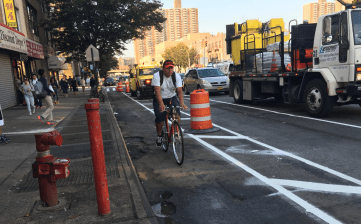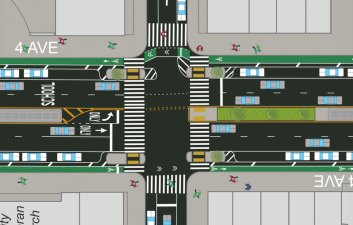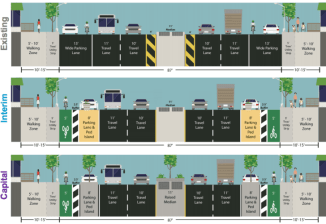DOT Caves on Marine Park Bike Lane, Will Remove Protection

A new protected bike lane segment on East 38th Street in Marine Park won’t be protected much longer. Even though the new layout provides a similar width for parking and driving as other residential streets in the area, DOT has caved to pressure from local residents who want to go back to having a short stretch of wide-open asphalt.
The two-way protected bike lane between Avenue U and Avenue V was approved by Brooklyn Community Board 18 earlier this year as part of a package of improvements to connect the neighborhood to the Jamaica Bay Greenway [PDF].

Local Council Member Alan Maisel pushed DOT to remove the parking protection. He said that because of the redesign, “people can’t get into their driveways,” sideview mirrors have been knocked off, and delivery trucks on the street are blocking traffic.
But the bike lane is next to a park and doesn’t affect access to driveways. The only difference for motorists is that the travel lane is now 12 feet wide, which is still on the wider side of standard city street dimensions.
A DOT spokesperson told the Brooklyn Daily that the parking protection will be removed by the end of the month, leaving cyclists exposed and the bike lane vulnerable to double-parking and other obstructions.
DOT did not respond to an inquiry from Streetsblog as to the exact design of the new bike lane. Since 38th Street is one-way for motor vehicles, the likely scenario is to swap the location of the two-way bike lane and the parking lane by the park, similar to the design of Plaza Street by Grand Army Plaza. Update: DOT has confirmed that the new configuration will be similar to Plaza Street, with parking along the curb, then a buffer, then a two-way bike lane running alongside car traffic.

The 38th Street bike lane is one of dozens of projects that the city hopes to implement as part of a recently-released plan to improve access to the Jamaica Bay Greenway [PDF]. In January, CB 18 rejected DOT’s initial proposal because it might one day have led to an on-street bike lane on Flatbush Avenue. (Currently, cyclists are allowed to bike on the sidewalk on this part of Flatbush.)
East 38th Street is a residential block, but at 40 feet wide, it’s much wider than typical 30-foot-wide residential streets in the area. Maisel noted that drivers use it to avoid busy Flatbush Avenue after exiting the Belt Parkway. By narrowing the roadway, the bike lane should get these motorists to drive more carefully on 38th.
If drivers are really knocking sideview mirrors, they should take the hint to slow down. Instead, DOT will cater to them and make the street more conducive to speeding.


